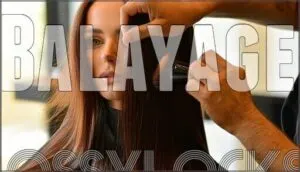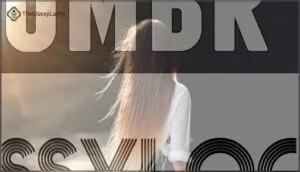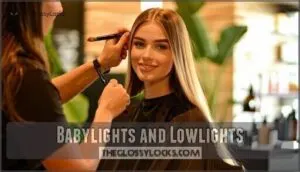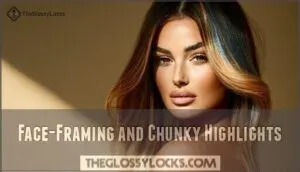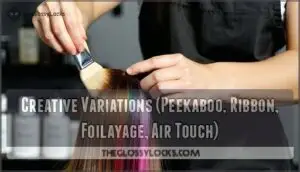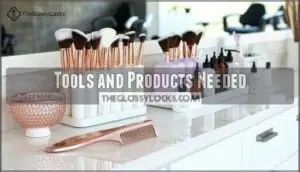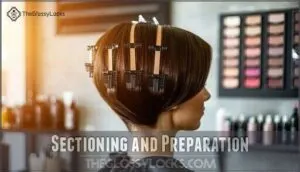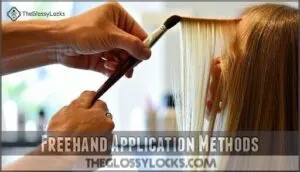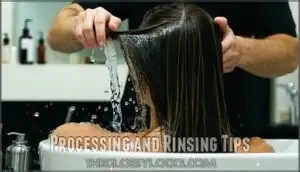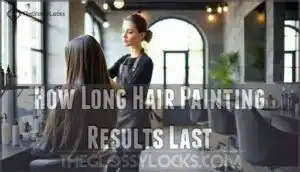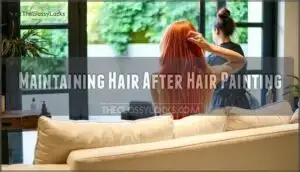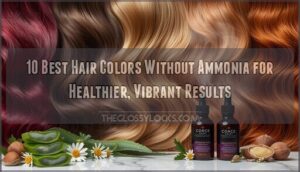This site is supported by our readers. We may earn a commission, at no cost to you, if you purchase through links.
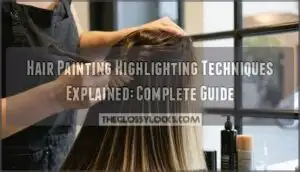 Hair painting highlighting techniques break free from traditional foil methods, giving you complete creative control over color placement through freehand brushwork. This groundbreaking approach creates natural-looking dimension that grows out gracefully without harsh lines, making it perfect for achieving that easy, sun-kissed look.
Hair painting highlighting techniques break free from traditional foil methods, giving you complete creative control over color placement through freehand brushwork. This groundbreaking approach creates natural-looking dimension that grows out gracefully without harsh lines, making it perfect for achieving that easy, sun-kissed look.
Popular techniques like balayage, ombré, and babylights each offer unique ways to customize your color story. The beauty lies in the artistry—your colorist literally paints highlights exactly where your hair needs them most, creating smooth transitions that complement your natural texture and movement.
Table Of Contents
Key Takeaways
- Hair painting techniques like balayage, ombré, and babylights use freehand brushwork instead of traditional foils, creating natural-looking highlights that grow out gracefully without harsh regrowth lines.
- These methods offer longer-lasting results with 8–12 weeks between touch-ups compared to traditional highlights, making them more cost-effective and low-maintenance for busy lifestyles.
- Professional application requires specific tools, including tail combs, application brushes, and lightener products, plus proper sectioning techniques to ensure even color placement and smooth transitions.
- Maintaining painted highlights demands sulfate-free shampoos, weekly deep conditioning masks, and UV protection to prevent fading and preserve color vibrancy between salon visits.
What is Hair Painting Highlighting?
Hair painting highlighting breaks free from traditional foil methods by using freehand brushwork to create natural-looking color transitions.
This technique, which emerged in the early 2000s, gives you complete control over placement and intensity for tailored results that grow out gracefully.
Origins and Evolution of Hair Painting
Hair painting’s roots trace back thousands of years, starting with ancient Greek women using olive oil and lemon juice for sun-kissed highlights around 600 BCE. Ancient dyes like henna transformed hair color in Egypt by 1500 BCE, while Renaissance artists mixed sulfur and honey for dramatic lightening effects.
These historical techniques laid the groundwork for modern balayage, which emerged in 1970s Paris. Cultural influences from European salons sparked the artistic development that revolutionized hair color trends, evolving from basic highlighting into today’s refined hair painting methods.
The history of hair dyeing is closely tied to hair color theory, which has been refined over centuries.
How Hair Painting Differs From Foil Highlights
Choosing between hair painting and foil highlights comes down to what look you’re after and how often you want salon visits.
Foil highlights give you bold, precise color with dramatic contrast, but you’ll need touch-ups every 6-8 weeks when your roots start showing.
Balayage creates those soft, sun-kissed highlights that look totally natural—no harsh lines or obvious regrowth.
You’ll save money too since you can go 8-12 weeks between touch-ups instead of the usual monthly salon visits.
For those seeking a more subtle look, considering hair coloring techniques can help in making an informed decision.
Benefits of Hair Painting Techniques
Think of hair painting as breaking free from the rigid rules of traditional highlighting—it’s where artistry meets rebellion, giving you natural-looking color that grows out gracefully instead of leaving harsh lines that scream "salon appointment overdue."
Hair painting breaks free from traditional highlighting rules, creating natural color that grows out gracefully without harsh regrowth lines
Hair painting delivers enhanced color retention and hair health benefits compared to traditional foil methods. You’ll enjoy low maintenance upkeep with natural look longevity factors that keep your hair dimension and brightness looking fresh for months, not weeks.
Popular Hair Painting Techniques Explained
Hair painting offers several game-changing techniques that can transform your look from ordinary to exceptional.
Whether you want subtle dimension or bold contrast, understanding these popular methods will help you choose the perfect technique to release your hair’s full potential.
Balayage
Imagine this: you’re an artist with a paintbrush, except your canvas is hair and your masterpiece creates sun-kissed dimension that looks like you just stepped off a Mediterranean beach.
That’s balayage—the queen of freehand techniques that’s dominated hair color trends for good reason. These natural highlights break every rule of traditional foiling, giving you seamless dimension that grows out gracefully without harsh lines.
Ombré
If you’ve ever dreamed of sunset hair that shifts from rich coffee brown to golden honey without harsh lines, ombré is your gateway to seamless glamour.
This hair gradient technique creates stunning fade effects by darkening roots and gradually lightening toward the ends. Unlike balayage highlights, ombré focuses on dramatic color shift through strategic hair painting and highlighting techniques during application.
Babylights and Lowlights
When you want to add subtle dimension without the drama of full highlights, babylights and lowlights become your secret weapons for creating that "I was born with it" glow. Babylights use hair texture to mimic natural sun-kissed strands with ultra-fine weaving, while lowlights add color depth through darker tones.
This balayage highlights approach creates natural looks that amplify your base color rather than overpower it, making these hair color trends perfect for first-time highlight clients.
Face-Framing and Chunky Highlights
Face-framing highlights are like spotlights for your features, while chunky highlights make a statement that says you’re not afraid to stand out from the crowd.
These hair frame techniques use strategic dimensional color placement to create natural hair contouring that enhances your bone structure. Chunky looks deliver bold contrast through wider sections, while face-framing highlights brighten your complexion with targeted hair painting around your face.
Creative Variations (Peekaboo, Ribbon, Foilayage, Air Touch)
Beyond the classic balayage and ombré lies a playground of creative highlighting techniques that’ll turn your hair into a masterpiece of hidden surprises and artistic flair.
Peekaboo highlights hide bold colors beneath your natural base, while ribbon highlights create striking streaks throughout.
The foilayage method combines freehand painting with foil precision, and the Air Touch style uses blow-drying to separate fine strands for ultra-natural dimension.
Step-by-Step Hair Painting Tutorial
Ready to transform your hair color game? This step-by-step tutorial breaks down professional hair painting techniques into manageable steps, giving you the confidence to master balayage, ombré, and other freehand methods like a pro.
Tools and Products Needed
Your hair painting toolkit is like an artist’s palette—you can’t create magic without the right tools. Grab tail combs for clean sections, application brushes for seamless balayage work, quality lighteners for those perfect babylights, toners to nail your color match, and a solid professional kit to tie it all together.
These hair brushes and color tools transform your vision into stunning reality.
Sectioning and Preparation
The secret to stunning hair painting lies in your sectioning strategy—mess this up, and even the most skilled colorist can’t save your highlights.
Start with clean, damp hair and create horizontal partings from ear to ear. Use clip techniques to separate your hair division into manageable quadrants.
Color mapping each section beforehand prevents missed spots and ensures even strand preparation. This systematic approach transforms balayage from guesswork into precision artistry.
Freehand Application Methods
Here’s where your artistic instincts take center stage—no foils, no boundaries, just pure creative control as you paint color exactly where it needs to go. Master these freehand techniques to create stunning dimensional layers that catch light naturally:
- Balayage sweeping – Use a paddle brush to paint lightener in long, smooth strokes following your hair’s natural fall
- Teasy lights placement – Gently backcomb sections before applying color for softer, blended transitions
- Hair painting precision – Control your lightener with a tint brush for targeted color placement on specific strands
- Weaving motion – Create ribbon-like highlights by painting in zigzag patterns through lifted sections
- Feathering technique – Blend edges with quick, light brush strokes to avoid harsh lines and achieve smooth gradation
Processing and Rinsing Tips
Hit that perfect shade and you’ve got seconds to make the call—rinse too fast and kiss your color goodbye, wait too long and hello crispy hair.
Use cool water for gentle rinsing to lock in hair moisture and color protection. Follow with toner application if needed, then finish with professional aftercare advice, including sulfate-free shampoo and deep conditioning treatments for ideal hair maintenance.
How to Choose The Right Technique
Finding the perfect hair painting technique really depends on what you’re working with. Your hair’s texture, how long it is, and your vibe all matter when figuring out what’s going to look amazing on you.
The key is matching your lifestyle and maintenance preferences with a technique that enhances your natural features and complements how you want to show up in the world.
Factors Based on Hair Type and Length
Breaking down your hair’s unique characteristics helps you choose the perfect highlighting technique. Hair texture plays a key role—curly hair requires 30% more product for even saturation, while fine hair absorbs bleach 25% faster, risking overprocessing.
Porosity effects matter too: highly porous hair shows 65% increased color absorption, demanding careful formula adjustments.
Length considerations influence technique selection—balayage works best on hair longer than 25cm, while babylights suit shorter styles. Density impact affects sectioning: high-density hair needs 8-12 divisions for full coverage.
Understanding these factors ensures your highlights complement your hair type perfectly.
Matching Techniques to Personal Style
Your lifestyle speaks volumes before you even step into the salon chair, and choosing a hair painting technique that mirrors your personality can make all the difference between looking like yourself and looking like someone else’s vision. Here’s how to match highlighting techniques to your personal style:
- Bold and Edgy: Chunky highlights or peekaboo colors create dramatic contrast
- Natural and Unstudied: Balayage mimics sun-kissed hair with subtle dimension
- Classic and Polished: Face-framing highlights refine your bone structure elegantly
- Creative and Unique: Ribbon or ombré techniques make custom color statements
Consider your face shape, skin tone, and hair texture when selecting color application methods that complement your individual aesthetic.
Consulting With a Professional Stylist
Don’t risk a hair disaster – get a pro stylist to figure out what your hair actually needs before you try any highlighting.
Through thorough hair analysis and color matching, experienced stylists assess your hair’s condition, natural tones, and lifestyle needs.
This stylist consultation creates a tailored style planning roadmap, securing your hair color transformations complement your features while maintaining healthy hair through proper highlighting techniques and ongoing client hair care guidance.
How Long Hair Painting Results Last
Hair painting results usually last 8-12 weeks before showing noticeable regrowth, though the natural blending means you can stretch appointments longer than traditional highlights.
Your hair’s porosity, the lightener used, and your maintenance routine all impact how long that fresh-from-the-salon look stays vibrant.
Expected Duration and Fade Patterns
Most hair painting results don’t just disappear overnight—they gracefully evolve over 8 to 16 weeks, with your natural grow-out pattern determining how smoothly the change unfolds.
You’ll notice subtle fade rates with balayage creating softer regrowth timing compared to traditional highlighting techniques.
Most clients schedule touch-up intervals every 12-14 weeks for ideal color longevity and maintenance schedules.
Factors Affecting Longevity
Your hair’s texture basically controls how long that fresh color sticks around. Fine hair? You’re looking at touch-ups every 6-8 weeks because it just can’t hold onto pigment like thicker strands can, while coarse hair keeps that vibrancy going strong for 3-4 months.
Haircare Routines matter too. Sulfate shampoos accelerate Color Upkeep needs by 40%, but color-safe products extend Maintenance by 2-4 weeks.
Environmental Impact can’t be ignored—UV rays cause 30% faster pigment breakdown, while hard water creates brassiness within weeks.
Chemical Processing also affects Hair Health and Care, with bleached highlights fading 20-30% quicker than gentler techniques.
Signs It’s Time for a Touch-Up
Even the most stunning hair painting job won’t last forever, and knowing when to book your next appointment can save you from walking around with obvious regrowth that screams "I need a touch-up!"
Watch for distinct lines at your roots, color fading that dulls your highlights, or when your natural hair color creates harsh contrasts.
Hair damage like dryness or breakage also signals it’s time for professional color correction and treatment to maintain your look.
Maintaining Hair After Hair Painting
Your hair painting masterpiece deserves VIP treatment to keep those gorgeous highlights looking fresh and vibrant for months.
The right care routine can make or break your investment, protecting your color while preventing damage that dulls your shine.
Recommended Hair Care Routines
Your hair color is an investment that deserves the same care you’d give any valuable asset—consistent maintenance keeps it vibrant and healthy for the long haul.
Start with sulfate-free shampoo twice weekly to maintain moisture balance without stripping color. Follow with deep hair masks every week for scalp care and enhanced hair health.
Incorporate nourishing hair oils between washes for ideal hair maintenance.
Best Products for Color-Treated Hair
Finding the right products for your painted hair is like choosing armor for battle – you need formulas that protect while preserving your colorist’s masterpiece.
Start with sulfate-free, moisturizing shampoos that won’t strip your color. Weekly hair masks restore moisture while color enhancers keep your highlights vibrant.
Choose products specifically designed for color-treated hair – they’re your best defense against fading.
Preventing Damage and Fading
Let’s be honest – keeping those gorgeous painted highlights from turning into a faded, brassy mess takes more strategy than just crossing your fingers and hoping for the best.
Heat styling without protection strips color faster than anything, so always use thermal sprays before blow-drying.
UV rays are your hair color’s worst enemy – invest in leave-in treatments with SPF for serious damage control and fading prevention.
Salon Vs. At-Home Maintenance Tips
Deciding between salon treatments and DIY touch-ups can feel like choosing between a perfectly crafted latte and instant coffee—both get the job done, but the experience and results tell a different story.
Professional color upkeep offers expert product selection and hair repair techniques, while at-home care provides convenient maintenance between salon visits for ideal color preservation.
Frequently Asked Questions (FAQs)
What maintenance products work best for painted highlights?
Like finding the right armor for battle, selecting proper maintenance products can make or break your painted highlights.
Color-protecting shampoos without sulfates, deep moisturizing conditioners, and weekly hair masks keep your investment vibrant longer while preventing damage.
Can hair painting damage chemically treated hair?
Combining hair painting with chemically treated hair increases treatment risks and potential hair breakage.
Previously processed hair shows greater vulnerability to color fading and chemical damage, requiring careful damage prevention strategies during balayage or highlights application.
How much does professional hair painting typically cost?
Professional hair painting at salons ranges from $150-$400, depending on your hair’s length and the technique’s complexity. Higher-end salons in metropolitan areas often charge premium rates for specialized Color Complexity services.
Several factors drive what you’ll pay for hair painting:
- Hair Length and density – Longer, thicker hair requires more product and time, increasing Salon Fees substantially
- Technique complexity – Simple Balayage costs less than intricate Highlights with multiple color placements
- Salon location and reputation – Premium Hair Salon locations charge 30-50% more than suburban shops
- Stylist experience level – Master colorists following current Hair Color Trends command higher Price Ranges than junior staff
Which hair painting works best for gray coverage?
Balayage stands as your strongest ally for Gray coverage, offering smooth Silver Blending through strategic Root Concealment.
This Hair Painting technique creates natural-looking Highlights while providing excellent Gray coverage compared to traditional Babylights or color correction methods.
Can you do hair painting on previously colored hair?
While previously colored hair presents unique challenges, skilled colorists can create stunning hair painting results through strategic Color Correction and Damage Assessment.
- Color Removal may be necessary to lighten dark base colors before applying highlights
- Toner Application becomes essential for achieving smooth blends with existing hair color
- Hair Repair treatments often precede the highlighting process to guarantee healthy results
- Balayage and Ombré highlights work beautifully over previous color with proper technique
- Color upkeep requires more frequent salon visits to maintain the perfect shade balance
Conclusion
Gone are the days when highlights meant sitting under a foil helmet like a satellite dish—hair painting highlighting techniques have revolutionized how we think about color.
You’re now equipped with the knowledge to break free from cookie-cutter looks and embrace techniques that work with your hair’s natural beauty.
Whether you choose balayage’s sun-kissed freedom or ombré’s dramatic fade, you’re in control of your color story.
- https://hairbynatashareid.com/hair-painting/
- https://www.factmr.com/report/3544/balayage-lightener-market
- https://www.salon.life/en/post/beauty-salon-statistics
- https://www.rejuvesalonandspa.com/blog-inner/understanding-the-different-highlighting-techniques-and-their-benefits
- https://laurakcollins.com/what-highlighting-technique-is-best-for-you/

